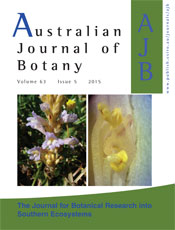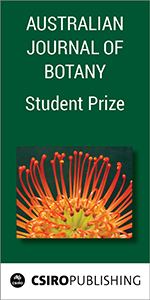Australian Journal of Botany
Volume 63
Number 5 2015
Legumes native to low-nutrient ecosystems need atmospheric nitrogen to survive. Phosphorus deficiency in the nodule bacterial composition’s role in biological nitrogen fixation (BNF) was investigated and it was found that BNF was more efficient, even though the bacterial composition was unaffected. The bacterial species inside legume nodules may be highly adapted to function in P-poor soils, for host N provision.
More and bigger seeds contribute to the invasive success of the Australian species A. longifolia in Portugal. This study compared selfing and reproductive success of A. longifolia showing no changes in selfing but an increase in the quantity and size of the seeds produced in the invaded region even for self-pollinated fruits. Intercontinental comparisons, such as this, are scarce but essential to understand invasion by exotic plants.
Worldwide there are many threatened cycads, and for trunkless species, determining what constitutes a mature plant and incorporating this information into a population structure is difficult. Demonstrated for one threatened, trunkless Australian cycad is a new, simple and effective method of determining maturity and population structure. This method and the knowledge derived will aid in its conservation management, and could be applied to other threatened cycads.
This study provides the first cytological approach on nine Polystichum species in order to increase our understanding of their systematic relationship. We found 2x, 4x and 8x ploidy levels, genome downsizing in polyploids, sexual reproduction, and spore size correlated with ploidy level. These evidences and a cytological literature survey suggest different evolutionary paths between species from southern South America and those of northern and central Andes Mountains.
We undertook a comprehensive study over a 3-year period to detail the growth, flowering, fruiting and germination biology of Persoonia longifolia (snottygobble). Plants produced vegetative growth, flowers and fruit during summer months and germination occurred during late winter from seed that is at least 1-year old, with these responses affected by fire. This research is vital for developing methods of returning this plant to rehabilitated areas of the jarrah forest, in south-western Australia.
Knowledge of the seed production of invasive species is vital for weed risk assessments and control programs. We investigated aspects of the seed production of broomrape and found that each flower can produce over 1000 viable seeds within 10 days of the flower dying. This species has similar seed traits to other broomrapes which are important weeds of crops worldwide.
Animal browsing can transform tree and forest. We found that wallabies and pademelons preferred to eat prickly box and native cherries, and avoided many wattles, but would eat all small trees as seedlings. Their browsing appeared to keep dry forests more open, and less prone to fire damage, than would otherwise have been the case.
Seeds of species adapted to the environments with seasonal climates commonly have sophisticated mechanisms for delaying germination, which contributes to the development of plants in favourable occasions. In this paper we investigate how the structures of palm seeds of Cerrado (Brazilian savannah) influence germination. We found that differences in both the embryo size as the seed coat thickness make the germination be distributed over time, which affects the pattern of geographic distribution of species.
Seed production areas (SPAs) are one way to ensure the regular supply of high genetic quality seed for restoration. This evaluation of two Yellow Box SPAs found that genetic diversity is similar to that of natural populations. These SPAs will provide high quality seed for future restoration projects and reduce the need to collect from wild populations.




